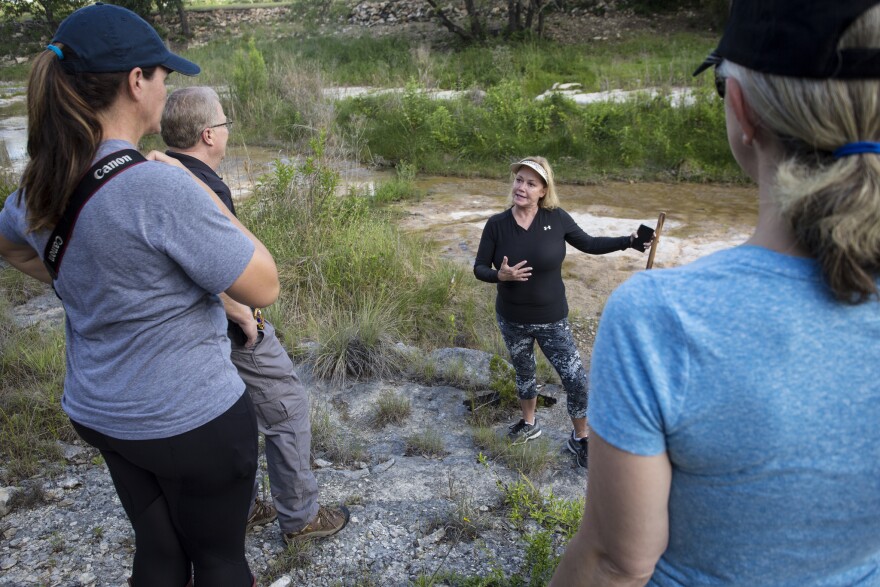This story was originally published on May 31, 2018.
Bee Cave or Bee Caves? Whether discussing the city or the road, it seems the names have vexed Austin-area residents for years.
Even more vexing? They may have been misnamed the whole time.
Several listeners submitted similar questions to our ATXplained series. The questions can be paraphrased simply: "Is it Bee Cave or Bee Caves?"
Stuff Of Legends
Bee Cave is the name of a city. Bee Caves (plural) is the name of a road – sometimes.
The city, just west of Austin, officially incorporated in 1987 to fend off annexation attempts by Austin. But its name is often pluralized, thanks to the road.

So, where exactly are the bees and the caves?
"According to legend," Bee Cave Mayor Pro Tem Bill Goodwin says, in the 1800s, there were limestone cliffs along Little Barton Creek – which flows through the city – that had big bee colonies. "That's where the area got its name."
Goodwin, who has lived in Bee Cave since the late '90s, says he's watched the city grow from fewer than 600 people to about 7,000 (a growth rate that makes Austin's seem downright pedestrian).
Goodwin has seen a lot – but not a lot of bees.
"Well, I've probably seen about as many bees as you have," he says.
An inordinate amount that would inspire a whole community or even a road to be named after them?
"No, I've not seen an inordinate quantity of bees in all these years," he says.
Any pictures of the bees?
"No," he says. "In fact, I've questioned whether or not there were ever any bees."
Confusion Abounds
Another version of Bee Cave's origin starts with Carl Beck, a general store owner who became the area's first postmaster in the 1870s. His daughter, Helen Lallier, told The Austin Statesman in 1969 that he named the area after a hive of "Mexican honey bees" attached to his store.
Subscribe to the ATXplained podcast
Lallier was interviewed in an attempt to clear up the debate over the city's name. In the piece, she produced several of his letters from the turn of the last century. Even then, the city's name was spelled both with and without an S.
It appears this debate has been going on a while.
The 'Legit Bee Caves'
Heather Cadenhead, the president of the Economic Development Board for Bee Cave, lives on 14 acres in the city and proudly takes folks on tours.

At the bottom of Little Barton Creek, Cadenhead shows a group a series of small hollows about midway up a 30-foot cliff. She says she once saw something that looked familiar at an old restaurant in Bee Cave.
"I went in there one day, and I saw a picture up on the wall about the bee caves," Cadenhead says. "I was like, 'Oh, that's on our property. Oh my gosh, that's the real bee caves!' I was like thrilled. I knew it was here, but I didn't know was the bee caves. That's where the bees made their hives. There may be even more, but these are the legit bee caves."
Opposite the cliff, across the creek is the old postmaster's land, giving some credence to the legitimacy of the bee caves.
An Unwelcome Environment
But today, there are no bees to be seen. There haven't been for some time.
And there's another problem with the story: Bees don't necessarily like to build hives high in dry hollows or caves.
"It's a possibility, but it would be more likely that they're in a tree hole or some sort of protected space in the ground," says Wizzie Brown, an entomologist with Texas A&M AgriLife Extension Service. "If it's just an overhang, I don't know how likely they would be to be in that particular area."
Join the ATXplained Facebook group
Also, there might be temperature issues with the limestone.
"Especially in summertime with the heat of the rock," she says, "it would be kind of difficult for them maybe to manage the temperature of the hive."
And, even though it is historically difficult to track some common bug names, she's never heard of "Mexican honey bees."
"I would probably go with Mexican honey wasps," she says. "Those are sometimes mistaken for bees, but they are honey producers and the colony is going to be completely different."
The wasps are bigger and round, and they like to hang from high places, like trees – or perhaps a cliffside.
Maybe all along, it should have been called Wasp Cave or Wasp Caves.
Hives Thrive
Some folks are trying to put the bees back in Bee Cave, assuming they were ever there.
Round Rock Honey has thousands of hives in the area; the hundreds in Bee Cave are thriving.
"The first 10 to 12 years of our company's history, we put so many hives out in the Bee Caves area and the Lakeway area and they didn't do well," says Kondrad Bouffard, the company's owner. "I don't know why, they just didn't do well. Lately, over the past few years, the Bee Caves and Lakeway area is one of our best-producing areas."
(While Bouffard is helping the bee population, he's not helping the rest of us keep straight whether the city is called Bee Cave or Bee Caves.)
Signs Of Uncertainty
The name has confused even those who make the road signs.
Heading west from Mopac, drivers who exit on Ranch-to-Market Road 2244 – or is it Farm-to-Market? – enter Rollingwood, where the road is called Bee Caves Road – plural.
Once you enter Westlake, the signs say you're on Bee Cave Road – except for a few blocks in the middle when you're inexplicably back on Bee Caves Road. Follow that road to the town of Bee Cave, and the signs tell you that you are mostly on Bee Caves Road, except at the intersection with Bee Cave Boulevard, where that sign reads Bee Cave Road.
As far as the road goes, whether it's Bee Cave or Caves, the answer is ... "yes."
_







